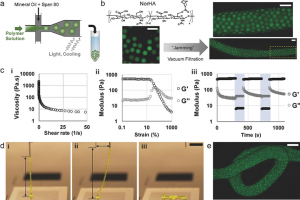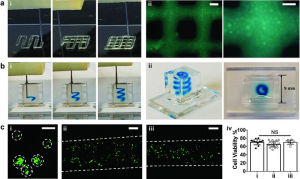A trio of researchers from the University of Pennsylvania have published a paper, titled “Jammed Microgel Inks for 3D Printing Applications,” on their use of jammed microgels as inks for bioprinting, in order to address the various limitations of 3D bioprinting with hydrogels. Researchers and scientists use 3D bioprinting to organize materials and cells into 3D structures, and while it can do amazing things, the technology still has a lot of challenges, like materials restrictions and achieving the correct resolution and stability for printed constructs. While soft hydrogel materials are often used in tissue engineering, thanks to tunable biochemical and biophysical properties, it’s hard to print them without using some sort of additive or modification.
The abstract reads, “3D printing involves the development of inks that exhibit the requisite properties for both printing and the intended application. In bioprinting, these inks are often hydrogels with controlled rheological properties that can be stabilized after deposition. Here, an alternate approach is developed where the ink is composed exclusively of jammed microgels, which are designed to incorporate a range of properties through microgel design (e.g., composition, size) and through the mixing of microgels. The jammed microgel inks are shear‐thinning to permit flow and rapidly recover upon deposition, including on surfaces or when deposited in 3D within hydrogel supports, and can be further stabilized with secondary cross‐linking. This platform allows the use of microgels engineered from various materials (e.g., thiol‐ene cross‐linked hyaluronic acid (HA), photo‐cross‐linked poly(ethylene glycol), thermo‐sensitive agarose) and that incorporate cells, where the jamming process and printing do not decrease cell viability. The versatility of this particle‐based approach opens up numerous potential biomedical applications through the printing of a more diverse set of inks.”
The microparticles found in jammed systems are packed pretty densely, and physical interactions with surrounding particles immobilize them. This results in macroscopic materials that behave as solids, until movement is induced by applied force.
“In the case of highly dense microgel formulations such as those used here, the microgel volume may deform elastically below the yield stress, but there is no movement of individual microgels. However, an application of sufficient stress to a volume of microgels results in movement of the microgels relative to one another as stress overcomes the packing forces that resist motion,” the researchers explained. “Further, upon reducing an applied stress below the yield stress, the system recovers. This flow and recovery of the jammed system in response to stress meets the design demands on inks for 3D printing, without the need for changes or rearrangements in the molecular structures of the materials for printing. Additionally, the jamming of microgels should be independent of microgel composition, potentially allowing the printing of any hydrogel material that can be processed into microgels.”
Jammed microgels work as bioinks because they allow cross‐linked hydrogel particles to be formed as an aggregate bulk, which can then be extruded as a stable filament without using any other material or having to engineer any interparticle interactions. The researchers formed microgel inks through the use of microfluidic devices.
The researchers said, “There is much versatility to this approach, allowing the fabrication of microgels from numerous materials, across a wide range of sizes, and incorporating biological components (e.g., cells, therapeutics).”
The team used norbornene‐modified hyaluronic acid (NorHA), poly(ethylene glycol) diacrylate (PEGDA), and agarose to make their microgels, which definitely displayed the kinds of rheological properties important for 3D printing, such as shear-thinning behavior, elastic response at low strains, and the ability to flow during extrusion and stabilize quickly after deposition. A modified Revolution XL 3D printer was used to fabricate the microgels into a four-layer lattice.
Mechanical forces disrupted the 3D printed structures as expected, so the team used post‐cross‐linking to chemically link the particles together.
“As an example, during the jamming process, additional cross‐linker (dithiothreitol) and photoinitiator (Irgacure 2959) were included, and ultraviolet (UV) light led to interparticle cross‐linking due to the presence of remaining unreacted norbornene groups. Printed and post‐cross‐linked lattice structures could subsequently be handled with forceps with no apparent loss in structural integrity,” the researchers said.
Additionally, when the printed and post‐cross‐linked cuboid structures were placed in cell culture medium, they held their dimensions and structure for a whole week, and the “compressive moduli of printed constructs” was increased by introducing interparticle bonds to post‐cross‐linking. This happened at a lower value than hydrogels that are made of the same formulation used to make microgels; when combined, these results that it’s possible to 3D print microgel inks, “as the jammed ink properties support printing and short‐term stability.”
“We believe the printing of jammed microgel inks opens up the possibility for the printing of a range of diverse materials and structures. To illustrate this, we utilized the gel‐in‐gel printing method of microgel inks into support hydrogels to print heterogeneous structures,” the researchers said.
“Further, microgel inks were used for the fabrication of microchannels within support hydrogels. To accomplish this, i) agarose‐based microgel inks were extruded into a support hydrogel, ii) the support hydrogel was stabilized by covalent cross‐linking, and iii) the agarose microgels were removed through dissolution with an increase in temperature to 37 °C and in the presence of agarase, leaving behind a perfusable channel within the stabilized support material.”
The research shows that microgel inks can definitely be used to 3D print heterogeneous structures without damaging any cells.
“The microgel approach permits control over cellular microenvironments through microgel design without the need for additives that may disrupt cell behavior,” the researchers concluded. “These unique materials offer exciting possibilities for new approaches to biofabrication and expand on the availability of inks for printing.”
Co-authors of the paper are Christopher B. Highley, Kwang Hoon Song, Andrew C. Daly, and Jason A. Burdick.
Discuss this research and other 3D printing topics at 3DPrintBoard.com or share your thoughts below.
Subscribe to Our Email Newsletter
Stay up-to-date on all the latest news from the 3D printing industry and receive information and offers from third party vendors.
You May Also Like
Precision at the Microscale: UK Researchers Advance Medical Devices with BMF’s 3D Printing Tech
University of Nottingham researchers are using Boston Micro Fabrication‘s (BMF) 3D printing technology to develop medical devices that improve compatibility with human tissue. Funded by a UK grant, this project...
GaeaStar and Verve Coffee Roasters Start Pilot Production of Sustainable 3D Printed Coffee Cups
Following a 2022 debut in Germany, GaeaStar, a startup based in San Francisco and Berlin, has begun US pilot production of its sustainable, disposable clay cups and bowls made with...
Meltio and Accufacture Unveil Robotic Metal 3D Printer Made in the US
Meltio has partnered with Michigan-based robotics firm Accufacture to introduce Alchemist 1, a robotic cell designed for wire-laser metal 3D printing made in the US. This new system represents a...
WASP Highlights Advances in Healthcare 3D Printing at Italy’s Exposanità 2024
WASP takes center stage at Italy’s leading healthcare expo, Exposanità 2024, demonstrating the transformative impact of its advanced 3D printing technologies on the medical sector. Known for its line of...




































